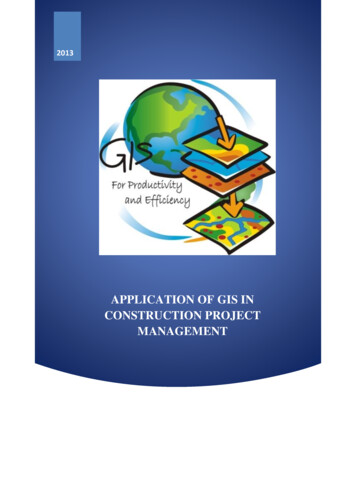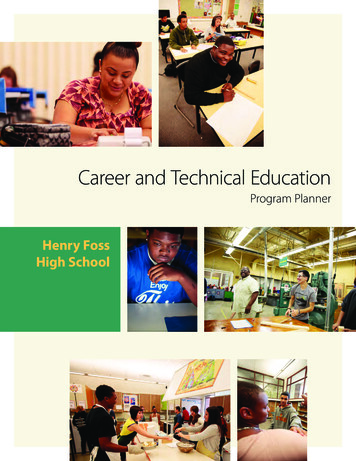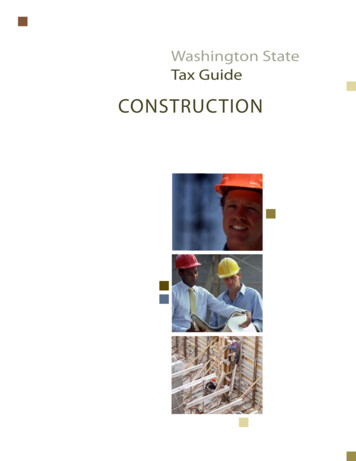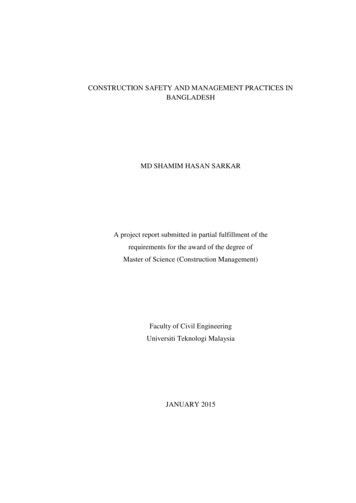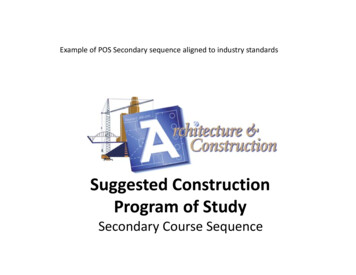
Transcription
Example of POS Secondary sequence aligned to industry standardsSuggested ConstructionProgram of StudySecondary Course Sequence
SAMPLENameLearner IDSchool/College/UniversityArchitecture and ConstructionCareer Cluster Plan of Study for Learners Parents Counselors ONLEVELSThis Career Cluster Plan of Study (based on the Architecture and Construction Career Cluster) includes NCCER curriculum that alings with industry standards and is recommended by the Architecture & Constructionstatewide Program Management Technical Committeecan to serve as a guide, along with other career planning materials, as learners continue on a career path. Courses listed within this plan are only recommendedcoursework and should be individualized to meet each learner’s educational and career goals. *This Plan of Study, used for learners at an educational institution, should be customized with course titles and appropriate highschool graduation requirements as well as college entrance requirements.English/ LanguageArtsMathScienceSocial Studies/SciencesInterest Inventory Administered and Plan of Study Initiated for all LearnersEnglish/Algebra IEarth or Life orState HistoryCivics orPhysical Science9 Language Arts IWorld HistoryEnglish/GeometryBiologyU.S. History10 Language Arts IIEnglish/Algebra IIPhysicsEconomicsPsychology11 Language Arts IIITechnical WritingCollege Placement Assessments-Academic/Career Advisement ProvidedEnglish/ Language Dependent onChemistrychosen pathway12 Arts IVOther Required CoursesOther ElectivesRecommendedElectivesLearner ActivitiesAll plans of study shouldmeet local and state highschool graduationrequirements and collegeentrance requirements.Certain local studentorganization activities suchas SkillsUSA are alsoimportant including publicspeaking, record keepingand work-basedexperiences.*Career and Technical Courses and/ or DegreeMajor Courses for Architecture andConstruction**Introduction to the Built Environment**NCCER CORE Instruction**Additional Courses Selected to CompleteProgram**Additional Courses Selected to CompleteProgramArticulation/Dual Credit Transcripted-Postsecondary courses may be taken/moved to the secondary level for articulation/dual credit purposes.English Composition Dependent onPhysicsAmerican Govt. or All plans of study need toContinue courses in selected y/with regard to required13Interpersonal Skills degrees, licenses,certifications or journeySpeech/EnvironmentalSociologyDependent onYearworker statuts. Certain localOral Communication chosen pathwayScienceBusiness Law14student organizationactivities may also beYearContinue courses in the area of specialization.important to include.15Year16**See course listings withhin this Draft POSCopyright 2007, States' Career Clusters Initiative. All Rights ReservedSAMPLEOccupations Relatingto This Career Cluster Architect Carpenter Civil Engineer Construction Foreman/Manager Contractor Demolition Engineer Drafter Drywall Installer Electrician Electronic Systems Technician Equipment/Material Manager General Contractor/Builder Heating, Ventilation, Air. Conditioning and Refrigeration. Mechanic Interior Designer Painter Paperhanger Plumber Project Estimator Project Inspector Roofer Safety Director Sheet Metal Worker Tile and Marble SetterSAMPLE
Industry Recognized CredentialsNational Registry Certificate Transcript Wallet‐card Confidential Portable Credentials Documentation of training & skills attainment1010
NCCER Curriculum – MeetsPerkins RequirementsThe National Center for Construction, Education, andResearch (NCCER) is a curriculum that is tied to nationalstandards. The NCCER curriculum comes withassessments that are aligned to industry standards withinthe Commercial and Industrial Construction CompetencyModel. WorkKeys and the National Career Readiness Cert. Math at Work‐Construction National Standards Curriculum and Assessments NCCER Accreditation Guidelines
INITIAL BROAD‐BASED COURSE – .5 ‐ 1 UNIT(UNITS TO BE DETERMINED BY LOCAL SCHOOL DISTRICT)Title: Introduction to the Built Environment1. A broad‐based course that introduces students to the wide range of occupationswithin the Architecture & Construction cluster, including Carpenter, Electrician,Plumber, Architect, Engineer, Project Manager, Drafter,2. There are two resources for this course:A. Careers in Construction. ISBN‐13: 978‐0‐13‐228605‐3B. A customized text compiled from NCCER construction texts – modules coverstandards approved by the Statewide Architecture & Construction TechnicalCommittee. (optional)
INTRODUCTION TO THE BUILT ENVIRONMENTArch-Const. Cluster Intro Course ModulesDraft Menu of Available ModulesCareers in Construction (ISBN13:780132286053) (10 Hours)Showcases the world of construction and career opportunities available to students interested inpursuing a construction career.Table of ContentsChapter 1Construction: America’s Powerhouse IndustryChapter 2Consider a Career in ConstructionChapter 3Is Construction for You?Chapter 4Career Guide: Carpenter, Plumber, Electrician, Mason, HVAC Technician, ElectronicSystems Technician, Welder, Heavy Equipment Operator, Other TradesChapter 5How Do I Get Started?Chapter 6Sources of InformationChapter 7ClosingHours and Content to be determined by local school district for balance of this course.MODULE 27101-06 – ORIENTATION TO THE CARPENTRY TRADE (2.5 Hours)1. Describe the history of the carpentry trade.2. Identify the aptitudes, behaviors, and skills needed to be a successful carpenter.3. Identify the training opportunities within the carpentry trade.4. Identify the career and entrepreneurial opportunities within the carpentry trade.5. Identify the responsibilities of a person working in the construction industry.6. State the personal characteristics of a professional.7. Explain the importance of safety in the construction industryMODULE 27102-06 – BUILDING MATERIALS, FASTENERS, AND ADHESIVES (7.5 Hours)1. Identify various types of building materials and their uses.2. State the uses of various types of hardwoods and softwoods.3. Identify the different grades and markings of wood building materials.4. Identify the safety precautions associated with building materials.5. Describe the proper method of storing and handling building materials.6. State the uses of various types of engineered lumber.7. Calculate the quantities of lumber and wood products using industry-standard methods.8. Describe the fasteners, anchors, and adhesives used in construction work and explain their uses.MODULE 27103-06 – HAND AND POWER TOOLS (10 Hours)1. Identify the hand tools commonly used by carpenters and describe their uses.2. Use hand tools in a safe and appropriate manner.3. State the general safety rules for operating all power tools, regardless of type.4. State the general rules for properly maintaining all power tools, regardless of type.5. Identify the portable power tools commonly used by carpenters and describe their uses.6. Use portable power tools in a safe and appropriate manner.MODULE 00105-09 Introduction to Construction Drawings (10 Hours)Familiarizes trainees with basic terms for construction drawings, components, and symbols.Explains the different types of drawings (civil, architectural, structural, mechanical,plumbing/piping, electrical, and fire protection) and instructs trainees on how to interpret and use
Intro TextListed first inIntro Course ModulesCopyright 2006Dimensions: 7-1/2 X 9-1/4Pages: 80Edition: 1st.ISBN-10: 0-13-228605-XISBN-13: 978-0-13-228605-3NCCER's Careers inConstruction showcases the world ofconstruction and career opportunitiesavailable to anyone interested inpursuing a construction career. Theguide includes a variety of picturesand illustrations as it reviews thepride and excitement of aconstruction career. Thisexceptionally produced trainee guidefeatures a highly illustrated design,technical hints and tips from industryexperts, review questions and awhole lot more! Key contentincludes: Construction - America'sPowerhouse Industry, Consider aCareer in Construction, IsConstruction for You?, Career Guide:Carpenter - Plumber - Electrician Mason - HVAC Technician Electronic Systems Technician Welder- Heavy Equipment Operator Other Trades, How Do I Get Started,Sources of Information, and Closing.
Pearson Publishing willcompile this traineeguide featuringselected modules fromSelected Modules:NCCER publicationsIntroduction to thethat support teachingBuilt Environmentstandards establishedby the Architecture &Construction ClusterStatewide TechnicalCommittee.Optional –Customized TextModules Listed inIntro Course Modules
NCCER CORE INSTRUCTION – 1 UNITTitle: NCCER CORE Curriculum(This course may be offered through a concurrent enrollmentif your community college offers this course agreement)1. The following four pages presents the outline of the NCCER CORE course.2. The two pages following the outline identify the two texts for this course:A. Core Curriculum: Introductory Craft Skills. ISBN‐ 978‐0‐13‐608637‐6B. From the Ground Up: Class Projects for Forming Framing & Finishing – projectsto support the CORE Curriculum ISBN‐ 978‐0‐13‐229164‐4
CORE CURRICULUM: Introductory Craft SkillsCompetencies / ObjectivesMODULE 00101‐09 – BASIC SAFETY1. Explain the idea of a safety culture and its importance in the construction crafts.2 Identify causes of accidents and the impact of accident costs.3. Explain the role of OSHA in job‐site safety.4. Explain OSHA’s General Duty Clause and 1926 CFR Subpart C.5. Recognize hazard recognition and risk assessment techniques.6. Explain fall protection, ladder, stair, and scaffold procedures and requirements.7. Identify struck‐by hazards and demonstrate safe working procedures and requirements.8. Identify caught‐in‐between hazards and demonstrate safe working procedures andrequirements.9. Define safe work procedures to use around electrical hazards.10. Demonstrate the use and care of appropriate personal protective equipment (PPE).11. Explain the importance of hazard communications (HazCom) and Material Safety DataSheets (MSDSs).12. Identify other construction hazards on your job site, including hazardous materialexposures, environmentalelements, welding and cutting hazards, confined spaces, and fires.
MODULE 00102‐09 – INTRODUCTION TO CONSTRUCTION MATH1. Add, subtract, multiply, and divide whole numbers, with and without a calculator.2. Use a standard ruler, a metric ruler, and a measuring tape to measure.3. Add, subtract, multiply, and divide fractions.4. Add, subtract, multiply, and divide decimals, with and without a calculator.5. Convert decimals to percentages and percentages to decimals.6. Convert fractions to decimals and decimals to fractions.7. Explain what the metric system is and how it is important in the construction trade.8. Recognize and use metric units of length, weight, volume, and temperature.9. Recognize some of the basic shapes used in the construction industry and apply basicgeometry to measure them.MODULE 00103‐09 – INTRODUCTION TO HAND TOOLS1. Recognize and identify some of the basic hand tools and their proper uses in theconstruction trade.2. Visually inspect hand tools to determine if they are safe to use.3. Safely use hand tools.MODULE 00104‐09 – INTRODUCTION TO POWER TOOLS1. Identify power tools commonly used in the construction trades.2. Use power tools safely.3. Explain how to maintain power tools properly.
MODULE 00105‐09 – INTRODUCTION TO CONSTRUCTION DRAWINGS1. Recognize and identify basic construction drawing terms, components, and symbols.2. Relate information on construction drawings to actual locations on the print.3. Recognize different classifications of construction drawings.4. Interpret and use drawing dimensions.MODULE 00106‐09 – BASIC RIGGING1. Identify and describe the use of slings and common rigging hardware.2. Describe basic inspection techniques and rejection criteria used for slings and hardware.3. Describe basic hitch configurations and their proper connections.4. Describe basic load‐handling safety practices.5. Demonstrate proper use of American National Standards Institute (ANSI) hand signals.MODULE 00107‐09 – BASIC COMMUNICATION SKILLS1. Interpret information and instructions presented in both verbal and written form.2. Communicate effectively in on‐the‐job situations using verbal and written skills.3. Communicate effectively on the job using electronic communication devices.
MODULE 00108‐09 – BASIC EMPLOYABILITY SKILLS1. Explain the role of an employee in the construction industry.2. Demonstrate critical thinking skills and the ability to solve problems using thoseskills.3. Demonstrate knowledge of computer systems and explain common uses forcomputers in the constructionindustry.4. Define effective relationship skills.5. Recognize workplace issues such as sexual harassment, stress, and substance abuse.MODULE 00109‐09 – INTRODUCTION TO MATERIALS HANDLING1. Define a load.2. Establish a pre‐task plan prior to moving a load.3. Use proper materials‐handling techniques.4. Choose appropriate materials‐handling equipment for the task.5. Recognize hazards and follow safety procedures required for materials handling.
Core CurriculumTextThis exceptionally producedtrainee guide features ahighly illustrated design,technical hints and tips fromindustry experts, reviewquestions and a whole lotmore! Nine modules in allprovides coverage of: BasicSafety, Introduction toConstruction Math,Introduction to Hand Tools,Introduction to Power Tools,Construction Drawings,Basic Rigging, BasicCommunication Skills, BasicEmployability Skills, andIntroduction to MaterialsHandling.
From the Ground Up, 2/eNCCER 2006Prentice Hall ISBN‐10: 0132291649Optional - Text toProvide Hands-onProjects toSupport theCore CurriculumBecause Contren training iscompetency‐based, studentsmust also demonstrate theability to perform tasks thatrelate to the subject matter.The forming, framing, andfinishing projects in this book willgive students the chance topractice many of the skills theyare learning about in theclassroom. In many projects,they will build things that willhelp their school or community.Several of the projects producearticles that can be sold to raisemoney to buy materials andequipment for the program ‐ thedoormat, plant stand, picnictable, and play house are goodexamples.
Additional courses tocomplete the program:Total must add up to the additional 1 to1.5 units needed to complete the 3 unitprogram course sequence minimum. Drafting / CAD ConstructionTechnology CarpentryFundamentals Electrical Plumbing HVAC‐R – Heating, Ventilation,Air Conditioning – Refrig. CEA ‐ Civil Engineering &Architecture (a PLTW course) Other courses within theArchitecture & Constructioncluster
ABOUT NCCER9NCCER is a not‐for‐profit 501(c)(3) education foundation created in 1996 as TheNational Center for Construction Education and Research. It was developed by morethan 125 construction CEOs and various association and academic leaders who unitedto revolutionize training for the construction industry. Sharing the common goal ofdeveloping a safe and productive workforce, these companies created a standardizedtraining and credentialing program for the industry. This progressive program hasevolved into curricula for more than 60 craft areas and assessments for over 70 examsoffered in over 4,000 NCCER‐accredited training and assessment centers across theUnited States.NCCER develops standardized construction and maintenance curricula andassessments with portable credentials. These credentials are tracked through NCCER’sNational Registry which allows organizations and companies to track the qualificationsof their craft professionals and/or check the qualifications of possible new hires. TheNational Registry also assists craft professionals by maintaining their records in asecure database.NCCER’s training process of accreditation, instructor certification, standardizedcurriculum, national registry, assessment, and certification is a key component in theindustry’s workforce development efforts. NCCER also drives multiple initiatives toenhance career development and recruitment efforts for the industry.
Research (NCCER) is a curriculum that is tied to national standards. The NCCER curriculum comes with assessments that are aligned to industry standards within the Commercial and Industrial Construction Competency Model. WorkKeys and the National Career Readiness Cert. Math at Work‐Construction




